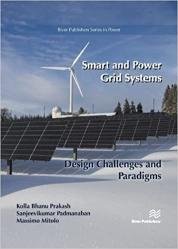Smart and Power Grid Systems – Design Challenges and Paradigms
- Добавил: literator
- Дата: 17-10-2022, 16:01
- Комментариев: 0
 Название: Smart and Power Grid Systems – Design Challenges and Paradigms
Название: Smart and Power Grid Systems – Design Challenges and ParadigmsАвтор: Kolla Bhanu Prakash, Sanjeevikumar Padmanaban
Издательство: River Publishers
Год: 2022
Страниц: 360
Язык: английский
Формат: pdf (true)
Размер: 10.2 MB
The Smart Grid (SG) represents an unprecedented opportunity to move the energy industry into a new era of reliability, availability, and efficiency that will contribute to our economic and environmental health. During the transition period, it will be critical to carry out testing, technology improvements, consumer education, development of standards and regulations, and information sharing between projects to ensure that the benefits we envision from the Smart Grid become a reality.
Today, an electricity disruption such as a blackout can have a domino effect―a series of failures that can affect banking, communications, traffic, and security. This is a particular threat in the winter, when homeowners can be left without heat. A smarter grid will add resiliency to our electric power system and make it better prepared to address emergencies such as severe storms, earthquakes, large solar flares, and terrorist attacks. Because of its two-way interactive capacity, the Smart Grid will allow for automatic rerouting when equipment fails or outages occur. This will minimize outages and minimize the effects when they do happen. When a power outage occurs, Smart Grid technologies will detect and isolate the outages, containing them before they become large-scale blackouts. The new technologies will also help ensure that electricity recovery resumes quickly and strategically after an emergency―routing electricity to emergency services first, for example. In addition, the Smart Grid will take greater advantage of customer-owned power generators to produce power when it is not available from utilities. By combining these "distributed generation" resources, a community could keep its health center, police department, traffic lights, phone system, and grocery stores operating during emergencies. In addition, the Smart Grid is a way to address an aging energy infrastructure that needs to be upgraded or replaced.
In the Chapter 1, the application of power electronics in the SGs is reviewed. The smart grid and its benefits are reviewed in the next section, and in the third section, power electronics in the SG are introduced. The fourth section describes the application of power electronics devices (power converters, FACTS, and HVDC devices) in SGs. In the fifth section, approaches to reduce cyber-attacks in electronic power systems in SGs are reviewed.
This book shows that Smart Grids can address energy efficiency, to bring increased awareness to consumers about the connection between electricity use and the environment, bring increased national security to our energy system―drawing on greater amounts of home-grown electricity that is more resistant to natural disasters and attack.
Contents:
Preface
Power Electronics in Smart Grid
Power Electronics in HVDC Transmission Systems
Optimal Multi-Objective Energy Management of Renewable Distributed Integration in Smart Distribution Grids Considering Uncertainties
Security Challenges in Smart Grid Management
Differential Protection Scheme along with Backup Blockchain System for DC Microgrid
Planning Active Distribution Systems Using Microgrid Formation
Overview on Reliability of PV Inverters in Grid-connected Applications
Energy Storage
A Comprehensive Review of Techniques for Enhancing Lifetime of Wireless Sensor Network
Soft Open Points in Active Distribution Systems
Future Advances in Wind Energy Engineering
Index
Скачать Smart and Power Grid Systems – Design Challenges and Paradigms
[related-news] [/related-news]
Внимание
Уважаемый посетитель, Вы зашли на сайт как незарегистрированный пользователь.
Мы рекомендуем Вам зарегистрироваться либо войти на сайт под своим именем.
Уважаемый посетитель, Вы зашли на сайт как незарегистрированный пользователь.
Мы рекомендуем Вам зарегистрироваться либо войти на сайт под своим именем.
